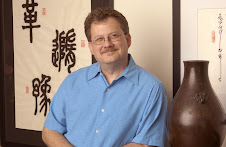The New Forest Difference: Postures
New Forest Tai Chi is completely unique in the Tai Chi world. Consequently, what constitutes a New Forest Tai Chi posture is likewise very unique.
In a conventional Tai Chi class, the students line up and silently follow a leader as they are lead through a rigidly predetermined routine performed at a set pace. The postures have old names like Stork Spreads Wings and Single Whip. Individuality and personal expression are sacrificed as the student attempts to fall in line with an ancient --and, often unclear-- standard. Success and failure in such an environment is determined by ones ability to submit to that standard and conform.
By contrast, the New Forest player (as we like to be called) approaches a Tai Chi posture as an engineer, an artist and a musician. Employing a proprietary written language and specialized teaching techniques, the New Forest teacher helps each student to educe, or "draw out", the authentic Tai Chi posture that lives within them. The student comes to understand the structure and physical intent of each posture, as well as its limits and design purpose. Then, as an artist, the student "creates" the posture in the same way that a painter explores a canvas, or as a sculptor shapes clay, wood or stone. Along the way,the fledgling player is exposed to the inspiration behind the posture and encouraged to think into it and experiment with injecting elements of their own life-experience that align with the postures message. Eventually, the player approaches the posture in the same way a musician approaches a musical composition. Expressiveness, emotion,and personal creativity take the forefront as the Tai Chi musician alters tempo and dynamics, the rhythm, tone and timbre of the posture. Sometimes the posture is played simply. At other times it's played with more complexity. But, the joyous moment for a New Forest Tai Chi Player comes when the composition unfolds of its own accord to meet the demands of the moment and the setting in which it is being played.
At this point, the performance of authentic bodymind music transforms itself into poetry that heralds the making of something truly wondrous. Success and failure in the New Forest is determined by ones ability to laugh, experiment, feel deeply, play and create. "Liberty" is our watchword.
Learning New Forest Tai Chi Postures
If you look at our schedule of classes you are likely to notice that during any giving week, the same posture is being presented and trained during many of the classes. Given the nature of the individual postures in New Forest Tai Chi, this isn't unusual. If there are, for example, five classes in a week that focus on posture #2 of River Seed, you can bet that each one of these classes will be quite different. Like peeling away the layers of an onion --and, to continue our music analogy-- the teacher will focus in on the melody of the posture in one class and the chords in another. In one session, the grace notes of each posture are explored, while the power of rhythmic changes become the lesson in the next session. Emotions and intent are explored in one class, while the movement of Qi (Life-Force Energy) is explained in another. Indeed, it takes a number of classes to fully explore any single New Forest Tai Chi posture. That having been said, it's one of our goals as teachers to turn you into a New Forest Tai Chi player in just one class! Just like a new fiddle player, we'll show you how to tune up, hold the instrument and bow, and make the basic motions. Then we'll show you how to play a simple posture, er....tune, like Cripple Creek. And, in no time at all, you'll be fiddlin'!
One more thing. What's true of each posture of New Forest Tai Chi is likewise true for the entire River Seed routine. The structure of the River Seed is circular and open, as all real Tai Chi should be. There are 39 postures in the River Seed and each one is an entry point into the composition. This allows you to begin your training at any time. Better still, no matter when you start or how often you come to class, you'll never be behind. Now, how cool is that?!
~ Sifu John A. Fey
Copyright © 2011 Fey Family Wu-Su, Inc. ~ All Rights Reserved

